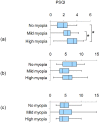Decreased sleep quality in high myopia children
- PMID: 27650408
- PMCID: PMC5030671
- DOI: 10.1038/srep33902
Decreased sleep quality in high myopia children
Abstract
The aim of the present study was to evaluate sleep quality in myopic children and adults. This cross sectional study surveyed 486 participants aged from 10 to 59 years with refractive errors using a questionnaire containing the Pittsburgh Sleep Quality Index (PSQI) and Hospital Anxiety and Depression Scale (HADS). Children (< 20 years) in the high myopia group exhibited the poorest PSQI scores (P < 0.01), while the adults showed no such correlations. Subscales of PSQI and HADS in children disclosed that the high myopia groups had the shortest sleep duration (P < 0.01), worst subjective sleep scores (P < 0.001), and latest bedtime (P < 0.05). Regression analyses in children significantly correlated myopic errors with PSQI (P < 0.05), sleep duration (P < 0.01), and bedtime (P < 0.01). Sleep efficacy (P < 0.05) and daytime dysfunction (P < 0.05) were significantly better in contact-lens users compared to the respective non-user groups across all participants. In conclusion, sleep quality in children was significantly correlated with myopic error, with the high myopia group worst affected.
Figures




References
Publication types
MeSH terms
LinkOut - more resources
Full Text Sources
Other Literature Sources
Medical

